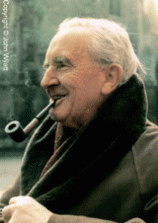Beren and Lúthien
Review
Beren and Lúthien
In the pantheon of legends that make up the bones of Middle-earth, none compares to that of BEREN AND LÚTHIEN. Referenced within The Lord of the Rings and mirrored by the relationship of Aragorn and Arwen, as well as being told in a more fuller fashion within THE SILMARILLION, it is a tale of true love entwined with utter heartbreak.
Lúthien is a beautiful half-elf maiden, the daughter of Thingol and Melian, a Maia who left the gardens of Lórien to explore Middle-earth. She was known as the fairest of all elves, if not the fairest of all creatures who ever walked Middle-earth, and none danced with such grace. Not even her mother. She is the great-grandmother of Elrond, a cousin of Galadriel, and it is from her line that Aragorn and the Kings of Gondor would come. Beren was a man, the son of Barahir, and was an outlaw under the shadowy control of Morgoth, the Dark Lord of Angband.
Beren happened upon Lúthien dancing and was immediately taken by her, returning to watch her again and again, eventually following her seemingly in secret as she made her way home. There he would whisper farewell to her, never knowing that she knew he followed her and that she was beginning to find herself falling in love with him. Eventually the two would meet and dance, and Beren bravely would ask Thingol for her hand.
Thingol would never agree to see his beloved daughter, the light of his people, shackled to the hand of a mortal man. In mocking challenge, he agreed to give her hand to Beren if he would seek out Morgoth and steal one of the famed Silmarils from his crown. Beren would not be swayed and, propelled forward by love, made his way to Angband to seek Morgoth and the jewel he was required to obtain.
"Though BEREN AND LÚTHIEN is a fantasy, a myth and an epic work of fiction, it was born of a real love. Reading each successive attempt and recreation, you can see the threads of that reality woven into the tale."
His mission is one of defeat. And without his knowledge, Lúthien set out on her own to find him and rescue him from the dungeons of Sauron, a regent of Morgoth. Though the two would successfully find each other, the tale would not end with rejoicing, for though Beren would eventually succeed in obtaining the Silmaril, he would ultimately pay for his love with his life. In her grief, Lúthien gave up her mortality and sang a song of great woe to Mandos, the Lord of the Dead, who was moved by her grief, allowing the two of them to return to Middle-earth, but they both would now be ruled by the fate of man --- they would be mortal and would, in time, die. Lúthien gave up the immortality of elves and chose to live with Beren until the end of their days.
BEREN AND LÚTHIEN takes this epic legend, one woven through the pages of THE SILMARILLION and intermingled with the greater events of the time, and tells the story singularly and contained as its own tale for the telling. But it is not just a simple telling. It is so much more.
It begins with THE TALE OF TINUVIEL, the earliest edition of the legend, conceived when J. R. R. Tolkien was serving in World War I. Interestingly, several very key changes have occurred over the years as he honed and perfected his mythology. In this first version, several names have changed, Beren is not a mortal man but an elf, and Sauron had not even become a thought yet. Story elements have been deleted but are displayed here to be enjoyed. Tolkien's son, Christopher, edited this collection and also includes verse segments of further attempts at the story, allowing for comparing and contrasting with the original vision as well as their final form in THE SILMARILLION. It is beautifully done, made all the more perfect by artwork from longtime Tolkien artist Alan Lee.
Christopher, who has spent decades poring over his father's notes and polishing them for release, explains in the opening of this book that it is likely the last he will edit. If so, it is a fitting end. His father considered the love story of Beren and Lúthien to be the key to the mythology of Middle-earth. To understand just how seriously this belief was held, he referred to his wife, Edith, as his Lúthien. She died a year before him, and his sense of loss was extraordinary. He wrote to Christopher that he wished to have Lúthien inscribed on her headstone, and in recalling the story of BEREN AND LÚTHIEN, he lamented, "But the story has gone crooked, and I am left, and I cannot plead before the inexorable Mandos."
Edith and John lay side by side in England beneath a marker bearing their names, with Lúthien inscribed alongside hers and Beren alongside his. Though BEREN AND LÚTHIEN is a fantasy, a myth and an epic work of fiction, it was born of a real love. Reading each successive attempt and recreation, you can see the threads of that reality woven into the tale.
Tolkien wrote, "None saw Beren and Lúthien leave the world or marked where at last their bodies lay." Thankfully we have the record of their time in the world and can rejoice in their legend, and, in this more singular edition, better come to understand their pivotal place in the pantheon of Middle-earth.
Reviewed by Stephen Hubbard on June 21, 2017





